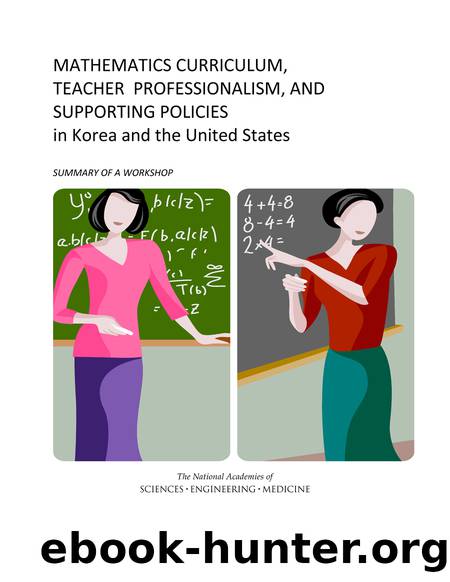Mathematics Curriculum, Teacher Professionalism, and Supporting Policies in Korea and the United States: Summary of a Workshop by Ana Ferreras

Author:Ana Ferreras
Language: eng
Format: epub
Publisher: The National Academies Press
Published: 2015-10-15T00:00:00+00:00
Dealing with such questions helps a teacher to consider learning trajectories.
Task Design
Kyong Mi Choi described features of instructional task design. Tasks are developed by teams of mathematicians, mathematics educators, and mathematics teachers to ensure mathematical correctness, and to consider how learners understand mathematics and possible misconceptions.
Tasks have five core elements: intuitive exploration, explanation, examples, practice, and extension. To promote intuitive exploration, tasks borrow concepts from everyday life, fill in a missing piece of reasoning, or use mathematical knowledge from earlier grades. For example, the Korean words for âterritoryâ and âregionâ are the same. To familiarize students with the mathematical meaning of âregion,â a Korean traditional door invokes studentsâ prior knowledge of a related meaning.
(After the presentation, Mi-Kyung Ju remarked that relating mathematical terminology to familiar words is important for equity because terminology is often borrowed from Chinese, and children from less educated families are less likely to be familiar with Chinese.)
The goal of explanation is to inform students so that they can figure out principles and meaning. Explanation includes defining mathematical terms and focusing on mathematical structures to be able to conceptualize, find algorithms, or contextualize. Core ideas and relevant background information are provided.
Example involves having students work through a typical example that reflects the core idea, justifying each step. Students reflect on mathematical processes, reasoning, and writing solutions correctly.
In speaking of practice, Choi quoted Confucius: âIs it not a pleasure after all to practice in due time what one has learned?â (Analects of Confucius, I.1). Practice allows students to make ânewâ knowledge their own by emulating and repeating what they have learned. Changes of mathematical structures when practicing enable students to reason mathematically and to make it a habit to apply relevant previous knowledge. Choi remarked that practice may be a factor in the superior mathematics performance shown by Korean students in international studies.
Extension gives students opportunities to explore different aspects that might have been overlooked or omitted. Students are encouraged to use multiple perspectives through problem solving, reasoning, and communication to connect mathematics and real-life activities. Choi noted that this focuses on objectification of mathematical content and process.
Procedural Competency and Conceptual Understanding
Ji Won Son described Korean approaches to assuring procedural fluency and conceptual understanding in the design of the curriculum. Conceptual understanding means comprehension of the meaning of mathematical concepts and operations. Procedural fluency refers to studentsâ skill in carrying out procedures flexibly, accurately, and appropriately (Kilpatrick, Swafford, and Findell, 2001). In particular, the National Council of Teachers of Mathematics stresses that instruction should begin with a conceptual rationale for procedures, as the algorithms alone do not help students think about the operations and what they mean.
However, in teaching and learning of operations, Korean curriculum and instruction aims to develop conceptual understanding and procedural fluency simultaneously (Son, 2011, 2012) by use of the following four approaches:
Instructional tasks in each lesson are designed based on the three-step method: Develop the meaning of the operation.
Develop strategies for computing.
Practice strategies and strategy selection.
Download
This site does not store any files on its server. We only index and link to content provided by other sites. Please contact the content providers to delete copyright contents if any and email us, we'll remove relevant links or contents immediately.
The Art of Coaching Workbook by Elena Aguilar(50967)
Trainspotting by Irvine Welsh(21518)
Twilight of the Idols With the Antichrist and Ecce Homo by Friedrich Nietzsche(18501)
Fangirl by Rainbow Rowell(9095)
Periodization Training for Sports by Tudor Bompa(8168)
Change Your Questions, Change Your Life by Marilee Adams(7634)
This Is How You Lose Her by Junot Diaz(6779)
Asking the Right Questions: A Guide to Critical Thinking by M. Neil Browne & Stuart M. Keeley(5631)
Grit by Angela Duckworth(5512)
Red Sparrow by Jason Matthews(5390)
Paper Towns by Green John(5087)
Room 212 by Kate Stewart(5035)
Ken Follett - World without end by Ken Follett(4643)
Housekeeping by Marilynne Robinson(4335)
The Sports Rules Book by Human Kinetics(4288)
Double Down (Diary of a Wimpy Kid Book 11) by Jeff Kinney(4204)
Papillon (English) by Henri Charrière(4195)
The Motorcycle Diaries by Ernesto Che Guevara(4009)
Exercise Technique Manual for Resistance Training by National Strength & Conditioning Association(3955)
